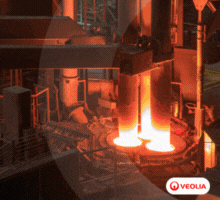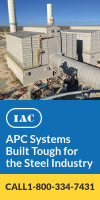OECD Steel Committee: Excess Capacity, Trade Friction Cloud Outlook for Global Steel Industry
12/22/2014 - The following is a statement from Risaburo Nezu, chairman of the OECD Steel Committee, issued after a meeting on 12 December 2014.
The Committee:
Following growth of 5.8% in 2013, global steel production growth has decelerated during the course of 2014. In the third quarter of 2014, world steel production increased by 1.6%, year-on-year, to 1 620 million metric tons (mmt) in annualized terms, slowing from rates of 2-2.5% in the first two quarters. Chinese steel production increased by 1.9 % in the third quarter of 2014, reaching 812 mmt in annualized terms. In the rest of the world, steel production was 807 mmt, in annualized terms, up 1.4% compared to the third quarter of 2013.
In 2013, global steel demand grew by 3.8%, but is expected to grow more slowly in 2014 and in 2015 with yearly growth rates of about 2%, according to the World Steel Association. The weakened growth momentum reflects a considerable deceleration in China’s steel demand growth and weakening consumption growth in other major emerging economies. However, in the developed world, the recovery remains potentially on track and should gain strength in certain economies in 2014, but not enough to offset the sluggishness in the emerging world, which accounts for over 70% of world steel use. For 2015, the picture is more optimistic for emerging economies in general, but China will continue to show low growth.
In line with these developments, the November 2014 forecasts of the World Steel Association indicate that world steel demand is expected to reach 1 562 mmt by the end of 2014 and 1 594 mmt by the end of 2015. Apparent steel use in developed economies is expected to increase by 4.3% in 2014 and 1.7% in 2015, marking a turnaround following the 0.2% demand contraction recorded in 2013. In emerging markets, consumption growth is expected to slow down to 1.7% in 2014, from a rate of 3.7% in 2013, and then pick up again in 2015 with a growth rate of 4.7%. Growth in Chinese steel consumption is expected to decelerate to 1.0% in 2014 and 0.8% in 2015, compared to the growth of 6.1% in 2013, according to the World Steel Association.
Excess capacity will remain a central challenge to the steel industry
As was noted in the Chair's summary at the Ministerial Council Meeting in May 2014, excess capacity is one of the main challenges facing the global steel sector today. The growing gap between global steelmaking capacity and demand has led to a deterioration in the financial situation of steelmakers, and has raised concerns about the longer-term economic viability and efficiency of the industry.
With investment projects continuing to increase in a number of economies while steel consumption growth is anticipated to remain moderate, the global imbalance will continue to pose risks for the industry for the foreseeable future. Non-OECD economies will continue to lead the capacity expansion in the global steel industry, with their share of world capacity expected to increase to 71.5% by 2017. One of main reasons behind capacity expansions is the existence of government supports, which distort market-based decision making for new investments.
While excess capacity will remain a challenge, measuring it precisely is difficult methodologically. The Committee discussed a methodological proposal to measure effective capacity developed by the Secretariat in consultation with a group of experts. Significant methodological challenges remain ahead and the Committee agreed that further work on capacity is needed over the biennium 2015-2016.
In parallel to this methodological work, policies that have implications on capacity developments will continue to be an important strand of the deliberations of the Steel Committee. The Committee discussed how to facilitate its work on capacity, with a sense of urgency, including ways to collect data on support measures by governments. This issue will be a significant focus in 2015.
Trade and trade policies
Following declines in global steel trade in 2012 and 2013, world steel export growth has picked up significantly during the course of 2014. Total exports from the ten largest steel exporting economies in the world increased by 7% in the first half of 2014, to an annualized level of 292 million metric tonnes. A key development has been the significant acceleration in steel export growth in some Asian economies.
The risk of trade conflicts in steel appears to have increased of late. Government interventions in the steel sector, excess capacity and oversupply, associated trade disruptions, and the industry’s low profitability are creating significant challenges for steel companies and spurring calls for more trade restrictive measures around the world.
Petitions for trade remedies to address unfair and injurious imports are increasing. Relative to many other goods-producing industries, the use of trade remedy measures is more frequent in the steel sector. Countervailing duties, antidumping duties and, to a lesser extent, safeguards emerge among the measures most frequently used by the steel industry, according to recent WTO data. The Committee discussed reasons why the steel industry is so affected by unfair trade practices. While trade remedy measures are a legitimate means to respond to unfair trade practices, the importance of countries applying trade remedies objectively and in accordance with international trade rules was highlighted.
Steel exporters are increasingly concerned about the imposition of localization restrictions in some countries. The Committee agreed to continue collecting information on these measures, where they are being implemented, and the potential problems they create for steel trade.
Members of the Committee also discussed options for greater co-operation, with a view to stemming the looming risk of a trade conflict. Members stressed the importance of raising transparency of subsidy usage, including the reduction of subsidy levels, sharing information about experiences with dealing with excess capacity and mitigating foreign investment barriers which could promote industry rationalization.
Energy efficiency is important for the steel industry
Energy efficiency can help addressing climate change challenges and increase industrial productivity. Energy management systems can save energy through low-cost operational improvements, either instead of or before technology capital investments. Both the energy and non-energy-related benefits of introducing an energy efficiency management system into company policy and case studies and good practices were also discussed. The Committee discussed a variety of policy and programme types and financial mechanisms that could be applied by governments to support the implementation of energy efficiency management systems.
Market and policy trends affecting trade in raw materials
A workshop hosted by South Africa and held in conjunction with the Steel Committee meeting brought together government and industry representatives from raw material importing and exporting economies to assess market trends and policy developments affecting trade in steelmaking raw materials. The aim of the workshop was to better understand the impacts of trade-restrictive raw material policies on the global steel industry and to explore policy approaches that would improve the longer-term efficiency and functioning of these markets.
Recently, steelmaking raw material markets have been affected by sluggish world demand and oversupply leading to an overall decline in prices. With continued investment activity in the relevant steelmaking mining sectors amid expected modest steel demand in the future, a quick rebound in raw material markets seems to be unlikely.
The developments in mining capacity and increased scrap availability in some regions are likely to affect the geographical distribution of raw materials supply in the future. While the dominant producers continued to attract most of the exploration activity, new areas such as Africa and Asia have emerged as steelmaking raw materials mining regions. In addition, as some regions further develop their steelmaking industry, the demand for raw materials is also likely to shift.
On the policy side, the last few years have seen an expansion in government efforts to regulate export flows of steel-related raw materials through the use of export restrictions in many countries. Export restrictions have contributed to volatility and uncertainty in markets, and have become a considerable source of trade friction.
Restrictive trade policies in the area of raw materials are a global challenge that requires well-informed and coordinated responses. The workshop emphasized the importance of open and well-functioning raw material markets for the health of the global steel industry and for realizing the full growth potential of the raw material sectors around the world.
Workshop participants debated the risks presented by restrictive policies on raw materials trade. In addition to their inherently discriminatory aspects, trade restrictive policies can lead to unintended consequences and result in retaliatory actions and impose significant costs on economies (see the recent publication by the OECD on Export Restrictions in Raw Materials Trade). The workshop stressed the importance of seeking multilateral solutions. The OECD Steel Committee can contribute to improving transparency in trade restrictive measures, and this will remain a high priority in its agenda.
The above information can be found on the OECD’s website.
- Held a workshop in conjunction with the Committee meeting, which focussed on emerging market and policy issues affecting trade in steelmaking raw materials;
- exchanged views on excess capacity in the global steel sector, including its implications for the health of the industry and the role of policy followed by governments;
- noted that numerous new steel plants continue to be built around the world, many supported by government interventions, accentuating the extent of the excess capacity challenge, which should be addressed with a sense of urgency;
- discussed the collection of data on support measures and challenges related to the measurement of effective capacity and agreed on future work on these issues;
- expressed concerns about trade frictions in steel and raw materials trade; and
- exchanged views on potential policy measures to improve steelmakers’ energy efficiency.
Following growth of 5.8% in 2013, global steel production growth has decelerated during the course of 2014. In the third quarter of 2014, world steel production increased by 1.6%, year-on-year, to 1 620 million metric tons (mmt) in annualized terms, slowing from rates of 2-2.5% in the first two quarters. Chinese steel production increased by 1.9 % in the third quarter of 2014, reaching 812 mmt in annualized terms. In the rest of the world, steel production was 807 mmt, in annualized terms, up 1.4% compared to the third quarter of 2013.
In 2013, global steel demand grew by 3.8%, but is expected to grow more slowly in 2014 and in 2015 with yearly growth rates of about 2%, according to the World Steel Association. The weakened growth momentum reflects a considerable deceleration in China’s steel demand growth and weakening consumption growth in other major emerging economies. However, in the developed world, the recovery remains potentially on track and should gain strength in certain economies in 2014, but not enough to offset the sluggishness in the emerging world, which accounts for over 70% of world steel use. For 2015, the picture is more optimistic for emerging economies in general, but China will continue to show low growth.
In line with these developments, the November 2014 forecasts of the World Steel Association indicate that world steel demand is expected to reach 1 562 mmt by the end of 2014 and 1 594 mmt by the end of 2015. Apparent steel use in developed economies is expected to increase by 4.3% in 2014 and 1.7% in 2015, marking a turnaround following the 0.2% demand contraction recorded in 2013. In emerging markets, consumption growth is expected to slow down to 1.7% in 2014, from a rate of 3.7% in 2013, and then pick up again in 2015 with a growth rate of 4.7%. Growth in Chinese steel consumption is expected to decelerate to 1.0% in 2014 and 0.8% in 2015, compared to the growth of 6.1% in 2013, according to the World Steel Association.
Excess capacity will remain a central challenge to the steel industry
As was noted in the Chair's summary at the Ministerial Council Meeting in May 2014, excess capacity is one of the main challenges facing the global steel sector today. The growing gap between global steelmaking capacity and demand has led to a deterioration in the financial situation of steelmakers, and has raised concerns about the longer-term economic viability and efficiency of the industry.
With investment projects continuing to increase in a number of economies while steel consumption growth is anticipated to remain moderate, the global imbalance will continue to pose risks for the industry for the foreseeable future. Non-OECD economies will continue to lead the capacity expansion in the global steel industry, with their share of world capacity expected to increase to 71.5% by 2017. One of main reasons behind capacity expansions is the existence of government supports, which distort market-based decision making for new investments.
While excess capacity will remain a challenge, measuring it precisely is difficult methodologically. The Committee discussed a methodological proposal to measure effective capacity developed by the Secretariat in consultation with a group of experts. Significant methodological challenges remain ahead and the Committee agreed that further work on capacity is needed over the biennium 2015-2016.
In parallel to this methodological work, policies that have implications on capacity developments will continue to be an important strand of the deliberations of the Steel Committee. The Committee discussed how to facilitate its work on capacity, with a sense of urgency, including ways to collect data on support measures by governments. This issue will be a significant focus in 2015.
Trade and trade policies
Following declines in global steel trade in 2012 and 2013, world steel export growth has picked up significantly during the course of 2014. Total exports from the ten largest steel exporting economies in the world increased by 7% in the first half of 2014, to an annualized level of 292 million metric tonnes. A key development has been the significant acceleration in steel export growth in some Asian economies.
The risk of trade conflicts in steel appears to have increased of late. Government interventions in the steel sector, excess capacity and oversupply, associated trade disruptions, and the industry’s low profitability are creating significant challenges for steel companies and spurring calls for more trade restrictive measures around the world.
Petitions for trade remedies to address unfair and injurious imports are increasing. Relative to many other goods-producing industries, the use of trade remedy measures is more frequent in the steel sector. Countervailing duties, antidumping duties and, to a lesser extent, safeguards emerge among the measures most frequently used by the steel industry, according to recent WTO data. The Committee discussed reasons why the steel industry is so affected by unfair trade practices. While trade remedy measures are a legitimate means to respond to unfair trade practices, the importance of countries applying trade remedies objectively and in accordance with international trade rules was highlighted.
Steel exporters are increasingly concerned about the imposition of localization restrictions in some countries. The Committee agreed to continue collecting information on these measures, where they are being implemented, and the potential problems they create for steel trade.
Members of the Committee also discussed options for greater co-operation, with a view to stemming the looming risk of a trade conflict. Members stressed the importance of raising transparency of subsidy usage, including the reduction of subsidy levels, sharing information about experiences with dealing with excess capacity and mitigating foreign investment barriers which could promote industry rationalization.
Energy efficiency is important for the steel industry
Energy efficiency can help addressing climate change challenges and increase industrial productivity. Energy management systems can save energy through low-cost operational improvements, either instead of or before technology capital investments. Both the energy and non-energy-related benefits of introducing an energy efficiency management system into company policy and case studies and good practices were also discussed. The Committee discussed a variety of policy and programme types and financial mechanisms that could be applied by governments to support the implementation of energy efficiency management systems.
Market and policy trends affecting trade in raw materials
A workshop hosted by South Africa and held in conjunction with the Steel Committee meeting brought together government and industry representatives from raw material importing and exporting economies to assess market trends and policy developments affecting trade in steelmaking raw materials. The aim of the workshop was to better understand the impacts of trade-restrictive raw material policies on the global steel industry and to explore policy approaches that would improve the longer-term efficiency and functioning of these markets.
Recently, steelmaking raw material markets have been affected by sluggish world demand and oversupply leading to an overall decline in prices. With continued investment activity in the relevant steelmaking mining sectors amid expected modest steel demand in the future, a quick rebound in raw material markets seems to be unlikely.
The developments in mining capacity and increased scrap availability in some regions are likely to affect the geographical distribution of raw materials supply in the future. While the dominant producers continued to attract most of the exploration activity, new areas such as Africa and Asia have emerged as steelmaking raw materials mining regions. In addition, as some regions further develop their steelmaking industry, the demand for raw materials is also likely to shift.
On the policy side, the last few years have seen an expansion in government efforts to regulate export flows of steel-related raw materials through the use of export restrictions in many countries. Export restrictions have contributed to volatility and uncertainty in markets, and have become a considerable source of trade friction.
Restrictive trade policies in the area of raw materials are a global challenge that requires well-informed and coordinated responses. The workshop emphasized the importance of open and well-functioning raw material markets for the health of the global steel industry and for realizing the full growth potential of the raw material sectors around the world.
Workshop participants debated the risks presented by restrictive policies on raw materials trade. In addition to their inherently discriminatory aspects, trade restrictive policies can lead to unintended consequences and result in retaliatory actions and impose significant costs on economies (see the recent publication by the OECD on Export Restrictions in Raw Materials Trade). The workshop stressed the importance of seeking multilateral solutions. The OECD Steel Committee can contribute to improving transparency in trade restrictive measures, and this will remain a high priority in its agenda.
The above information can be found on the OECD’s website.



.jpg?lang=en-US&ext=.jpg)
-(1).gif?width=220&height=200&mediaprotectionhash=8011a71ede637cd523c67b1296fc49e6151560fde821a46f29cc85998cc76615&ext=.gif)



